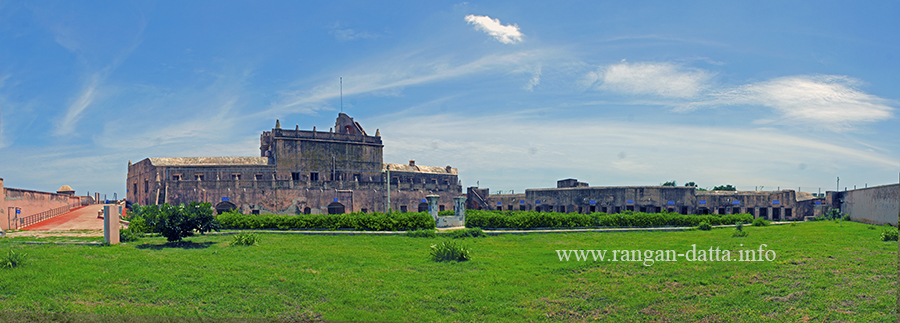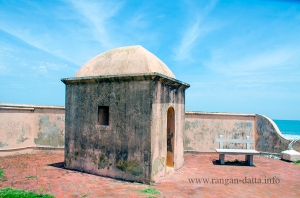Dansborg Fort, Tranquebar (Tharangambadi)
Dansborg Fort
Tranquebar (Tharangambadi), Tamil Nadu (TN)
Also see: FAM Trip of Tamil Nadu
Although India has been a British colony for almost two centuries but few pockets have been under the occupation of other European powers. Goa and Pondicherry remained under the Portuguese and French occupation respectively even after independence of India in 1947.
Apart from French and Portuguese the Dutch and Danish also had there share of tiny colonies spread across British India. West Bengal also had its share of European colonies along the River Hooghly
More on:
Tranquebar is one such European colony in present day Tamil Nadu of the coast of Bay of Bengal. It was a Danish colony from 1620 – 1845. The Tamil name for Tranquebar was Tharangambadi, literally meaning the “house of musical waves.”
Tranquebar still has its Danish colonial structures complete with a city gate, cemetery, couple of Churches, several colonial buildings but the structure that stands out is the Dansborg Fort, popularly known as the Danish Fort of Tranquebar.
The Danish colony of Tranquebar was founded on 19 November 1620 when it was visited by Ove Gjedde, the envoy of Danish King Christian IV.
Ove Gjedde got in touch with Raghunatha Nayak, who agreed to transfer the village of Tharangambadi to the Danes in exchange of an annual tribute and Tharangambadi came to be known as Tranqubar.
The tribute was fixed as ₹3111 per annual and a total of 8 km (5.0 mi) by 4 km (2.5 mi) area was ceded to the Danish mission. The treaty allowed the Danes to collect taxes and trade from the Tranquebar area. The treaty signed in a golden leaf manuscript is maintained in the Danish royal archives in Copenhagen.
With the transfer of power the sleepy fishing village of Tharangambadi turned into a major trading post fetching a huge amount of profit to the Danish East India Company.
The village soon turned into a fortified settlement surrounded by high walls protected by massive bastions and punctured by ornamental gateways. Soon churches, mansions, cemetery and fort came up within the walled complex and in the process turning sleepy fisherman’s abode into a small fortified colonial town.
On 9 July 1706 Tranquebar witnessed the arrival of two German Lutheran Missionaries Bartholomäus Ziegenbalg and Heinrich Plütschau. Later Bartholomäus Ziegenbalg went on to introduce the Tamil printing press and went on to translate the New Testament of Bible in Tamil and print it.
In the process he became the first man to introduce printing press in India and print the Bible (only New Testament) in an Indian language (Tamil). He went on to print several other books in Tamil
Tranquebar continued to prosper a trading post fetching huge revenues to the Danes but over the decades and centuries things started taking a turn.
The profits started diminishing and it was no longer profitable for the Danes to maintain their territories in India.
Finally the Danes decided to sell Tranquebar along with the other settlement of Serampore in West Bengal to the British East India Company and move out of India.
Although the Danes have long left Tranquebar and so have the British but the town still has its colonial charm complete with European styled architecture and reminds one of the small fortified citadel towns of Europe.
More on:
`
Among the array of colonial structures of Tranquebar one that stands out is the Dansborg Fort, popularly known as the Danish Fort of Tranquebar. After independence in 1947 the fort was turned into a Inspection Bungalow. In 1978 the fort was taken up the Tamil Nadu State Archaeology Department and presently houses a museum.
Exhibits inside Museum of Dansborg Fort, Tranquebar
Although Dansborg Fort is the second largest fort of the former Danish empire but it is small in size. The fort is trapezoidal in shape with the watergate located on the eastern side. Presently entry is through the northern side.
The entrance leads to an open courtyard with a manicured lawn. There are structures on the eastern and southern sides. The southern side is one-storied and includes soldiers barrack, kitchen and storerooms. The eastern side rises to a second level and houses officers’ quarters, offices and chapel.
This elevated eastern portion, facing the sea, houses the small museum. Spread over a couple of rooms the museum contains a host of exhibits covering a vast array of topics. From models of European Ships to stone sculptures of Hindu deities and from fort documents to the skeleton of dolphins.
Sadly are displayed randomly without any proper designated gallery. The museum also displays a set of photos of Danish kings, a list of Danish governors and a list of ships visiting Tranquebar during the Danish rule.
A lone guardhouse still stands on the southeastern corner and the rampant offers a great view of the sea and town of Tranquebar. The fort is best viewed from the beach and Tranquebar (Tharangambadi), which has one of the most ozone (O3) rich beaches of the world.
More on:
`
Note:
- This blog post is part of a FAM (Familiarization) Tour organized by Tamil Nadu Tourism Development Corporation (TTDC)
More on:
-
November 24, 2021 at 2:04 PMMy Blog
Blogroll
Explore India
Blog Index:
- Kolkata (Calcutta)
- West Bengal (Excluding Kolkata)
- Andhra Pradesh and Telengana
- Bihar
- Delhi
- Jammu & Kashmir and Ladakh
- Jharkhand
- Karnataka
- Madhya Pradesh
- Maharashtra
- Orissa
- Sikkim
- Tamil Nadu
- Uttar Pradesh
- Uttarakhand
Popular Trending
Top Posts & Pages
- Historical Sites of Purulia District
- Pancha Rathas, Mahabalipuram (Mamallapuram)
- Jatar Deul and finally the Horse Race
- Shore Temple, Mahabalipuram (Mamallapuram)
- Semaphore Towers ~ A Pre - Telegram Communication System
- Book Review ~ The Lost Generation by Nidhi Dugar Kundalia
- Brihadeshwara Temple, Gangaikonda Cholapuram
- Maa Phire Elo, Durga Museum, Rabindra Sarobar
- Pakbirra, remains of a temple town in Purulia District
- Kurseong, The Land of White Orchid
Recent Posts
- Food trail of Rajshahi region of Bangladesh
- Association of Buddhist Tour Operators (ABTO) Convention, Kushinagar
- Jim Thompson House, Bangkok – Intriguing tale of a silk tycoon
- Monsieur Raymond’s Tomb — Hyderabad’s French Connect
- Jaunpur, Uttar Pradesh – Fort, Mosques and more
- Shahi Qila, Jaunpur – A citadel on the banks of Gomti River
- Lal Khan’s Tomb, Varanasi – A forgotten tomb of a minister of Varanasi
- Rajghat, Varanasi – The oldest part of one of the world’s oldest cities
- Pune University – Heritage Tour
- Pune Zero Stone, a failed conservation and landscaping project
Archives
Categories
Blog Stats
- 2,010,536 people accidentally bumped into my blog

























